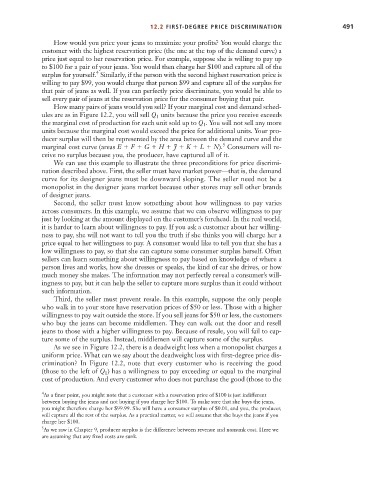Page 517 - Microeconomics, Fourth Edition
P. 517
c12capturingsurplus.qxd 7/22/10 10:41 AM Page 491
12.2 FIRST-DEGREE PRICE DISCRIMINATION 491
How would you price your jeans to maximize your profits? You would charge the
customer with the highest reservation price (the one at the top of the demand curve) a
price just equal to her reservation price. For example, suppose she is willing to pay up
to $100 for a pair of your jeans. You would then charge her $100 and capture all of the
4
surplus for yourself. Similarly, if the person with the second highest reservation price is
willing to pay $99, you would charge that person $99 and capture all of the surplus for
that pair of jeans as well. If you can perfectly price discriminate, you would be able to
sell every pair of jeans at the reservation price for the consumer buying that pair.
How many pairs of jeans would you sell? If your marginal cost and demand sched-
ules are as in Figure 12.2, you will sell Q units because the price you receive exceeds
1
the marginal cost of production for each unit sold up to Q . You will not sell any more
1
units because the marginal cost would exceed the price for additional units. Your pro-
ducer surplus will then be represented by the area between the demand curve and the
5
marginal cost curve (areas E F G H J K L N). Consumers will re-
ceive no surplus because you, the producer, have captured all of it.
We can use this example to illustrate the three preconditions for price discrimi-
nation described above. First, the seller must have market power—that is, the demand
curve for its designer jeans must be downward sloping. The seller need not be a
monopolist in the designer jeans market because other stores may sell other brands
of designer jeans.
Second, the seller must know something about how willingness to pay varies
across consumers. In this example, we assume that we can observe willingness to pay
just by looking at the amount displayed on the customer’s forehead. In the real world,
it is harder to learn about willingness to pay. If you ask a customer about her willing-
ness to pay, she will not want to tell you the truth if she thinks you will charge her a
price equal to her willingness to pay. A consumer would like to tell you that she has a
low willingness to pay, so that she can capture some consumer surplus herself. Often
sellers can learn something about willingness to pay based on knowledge of where a
person lives and works, how she dresses or speaks, the kind of car she drives, or how
much money she makes. The information may not perfectly reveal a consumer’s will-
ingness to pay, but it can help the seller to capture more surplus than it could without
such information.
Third, the seller must prevent resale. In this example, suppose the only people
who walk in to your store have reservation prices of $50 or less. Those with a higher
willingness to pay wait outside the store. If you sell jeans for $50 or less, the customers
who buy the jeans can become middlemen. They can walk out the door and resell
jeans to those with a higher willingness to pay. Because of resale, you will fail to cap-
ture some of the surplus. Instead, middlemen will capture some of the surplus.
As we see in Figure 12.2, there is a deadweight loss when a monopolist charges a
uniform price. What can we say about the deadweight loss with first-degree price dis-
crimination? In Figure 12.2, note that every customer who is receiving the good
(those to the left of Q ) has a willingness to pay exceeding or equal to the marginal
1
cost of production. And every customer who does not purchase the good (those to the
4 As a finer point, you might note that a customer with a reservation price of $100 is just indifferent
between buying the jeans and not buying if you charge her $100. To make sure that she buys the jeans,
you might therefore charge her $99.99. She will have a consumer surplus of $0.01, and you, the producer,
will capture all the rest of the surplus. As a practical matter, we will assume that she buys the jeans if you
charge her $100.
5 As we saw in Chapter 9, producer surplus is the difference between revenue and nonsunk cost. Here we
are assuming that any fixed costs are sunk.

